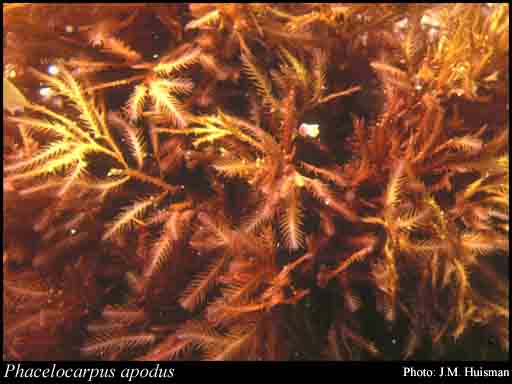- Reference
- Acta Univ.Lund. 31 (1872)
- Conservation Code
- Not threatened
- Naturalised Status
- Native to Western Australia
- Name Status
- Current

Scientific Description
Habit and structure. Thallus medium to dark red-brown, (5–)10–30 cm high, with a terete stipe 5–20 mm long and 1–3(–4) mm in diameter, much branched irregularly but largely complanately for 4–5 orders, branches 1–2(–2.5) mm broad, rachides terete below, mostly compressed and (400–)500–800 µm broad, usually with a distinct midrib and marginal flanges. All branches bearing distichous, compressed, evenly tapering, pointed, ramuli, (150–)250–400 µm in basal width, 1–2 mm long, separated on the rachis by rounded sinuses 100–150(–300) µm wide; upper ramuli often but not always reflexed alternately above and below the plane of branching. Holdfast discoid, 2–5 mm across; epilithic or rarely epiphytic. Structure uniaxial, developing a prominent axial filament with four periaxial cells, the lateral two developing into filaments with alternate ones forming the ramuli; rhizoids moderately well developed around the axial filament. Cortex pseudoparenchymatous, inner cells ovoid and 30–50 µm in diameter, outer cells 1.5–2.5 µm in diameter and L/D 0.8–1.5; refractive inclusions in cortical cells absent or present but sometimes inconspicuous; rhodoplasts discoid to elongate.
Reproduction.All reproductive bodies on the rachis margin, developed from the periaxial filament between two teeth. Sexual thalli dioecious. Procarps with one or two 2-celled carpogonial branches and an auxiliary cell, formed in clusters on short axillary branchlets. Cystocarps stalked, ovoid, bilabiate, 500–900 µm broad, with a thick pericarp along the ostiolar slit, enclosing the carposporophyte with a basal reticulate fusion cell and erect gonimoblast filaments with paired, ovoid to clavate, terminal carposporangia 3–6 µm in diameter. Spermatangial nemathecia ovoid, 450–700 µm in diameter, sessile on rachis between the teeth, with spermatangia in channels separated by sterile tissue. Tetrasporangial nemathecia usually sessile, sometimes short-stalked and occasionally surmounted with sterile branchlets, subspherical to ovoid, 350–600 µm in diameter, with tetrasporangia in channels between sterile tissue, elongate, 25–45 µm long and 6–9 µm in diameter, zonately divided.
Distribution.Whitford Beach, W. Aust., to Broulee, N.S.W., and around Tas.
Habitat. P. apodus is usually a moderately deep-water species.
[After Womersley, Mar. Benthic Fl. Southern Australia IIIA: 398–400 (1994)]
Distribution
- IBRA Regions
- Esperance Plains.
- IBRA Subregions
- Recherche.
- IMCRA Regions
- Central West Coast, WA South Coast.
- Local Government Areas (LGAs)
- Dandaragan, Esperance.